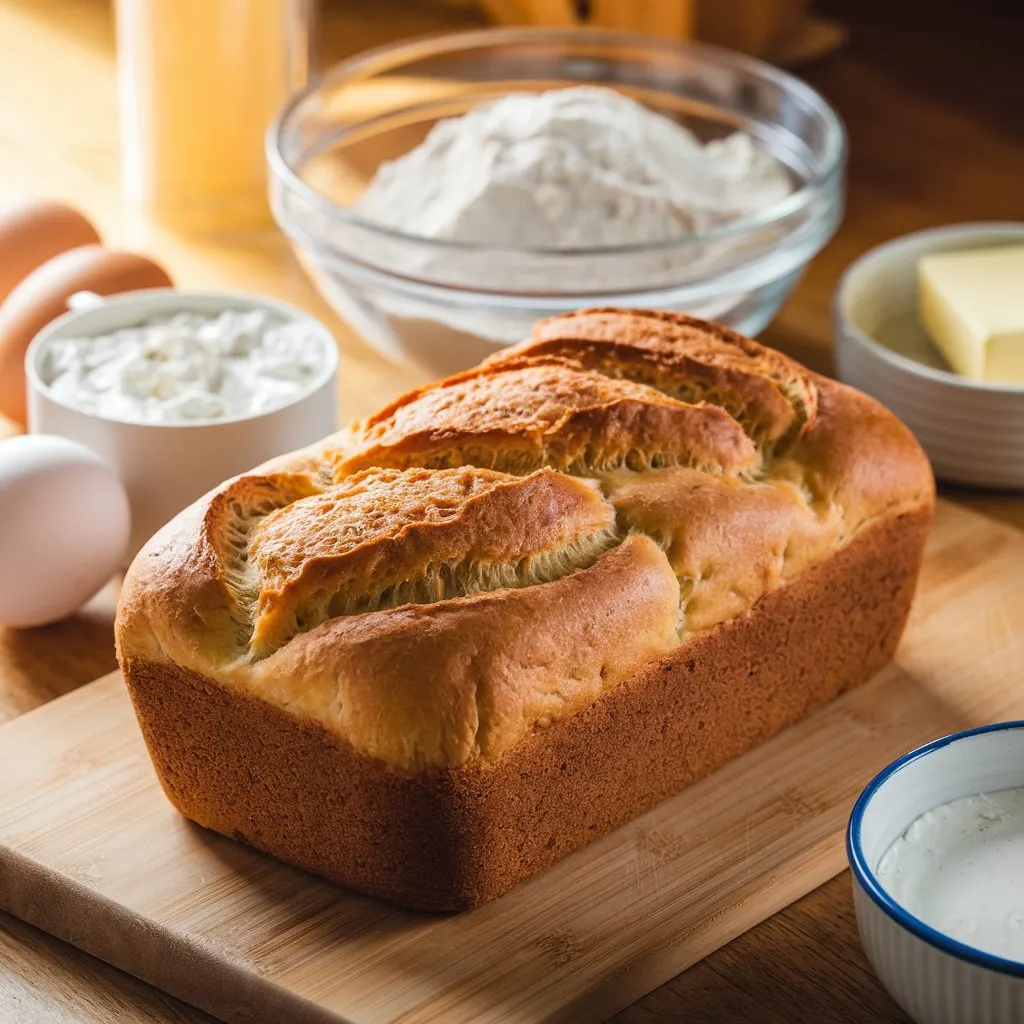Ever thought of making soft, tasty bread with just a few ingredients? You’re in for a treat! This cottage cheese bread recipe is a game-changer. It offers a unique taste and texture that will make your taste buds happy. As a home baker, I’ve worked hard to perfect this recipe, and I’m excited to share it with you.
The secret to this bread? Cottage cheese. That creamy, tangy dairy product is about to become your kitchen’s new favorite. It adds a rich, moist flavor to the dough, making this bread stand out.
This cottage cheese bread recipe is special because it’s both simple and indulgent. With only 5 easy-to-find ingredients, you can make a loaf that will wow everyone. It’s perfect for both experienced bakers and beginners looking to try homemade bread.
What is Cottage Cheese Bread?
Cottage cheese bread is a special kind of bread. It uses cottage cheese, which is creamy and full of protein. This makes the bread soft, moist, and healthy.
Cottage cheese is a common ingredient in baking. It adds moisture and a unique texture to baked goods.
Overview of Cottage Cheese in Baking
Using cottage cheese in bread started in the early 1900s. Home cooks found it versatile in the kitchen. It makes bread moist and tender, with a mild flavor.
When mixed with flour, eggs, and other ingredients, cottage cheese bread becomes soft and fluffy. It’s different from regular yeast-based loaves.
Key Benefits of Using Cottage Cheese
- Increased Protein Content: Cottage cheese is a rich source of protein, making cottage cheese bread a more nutritious option compared to traditional bread recipes.
- Moisture Retention: The high moisture content of cottage cheese helps to keep cottage cheese bread soft and fresh for longer, reducing the risk of it becoming dry or crumbly.
- Improved Texture: The creamy texture of cottage cheese contributes to the soft, tender crumb of the bread, creating a delightful mouthfeel.
By adding cottage cheese to your bread-making, you get a tasty and healthy choice. It’s packed with the benefits of this versatile dairy ingredient.
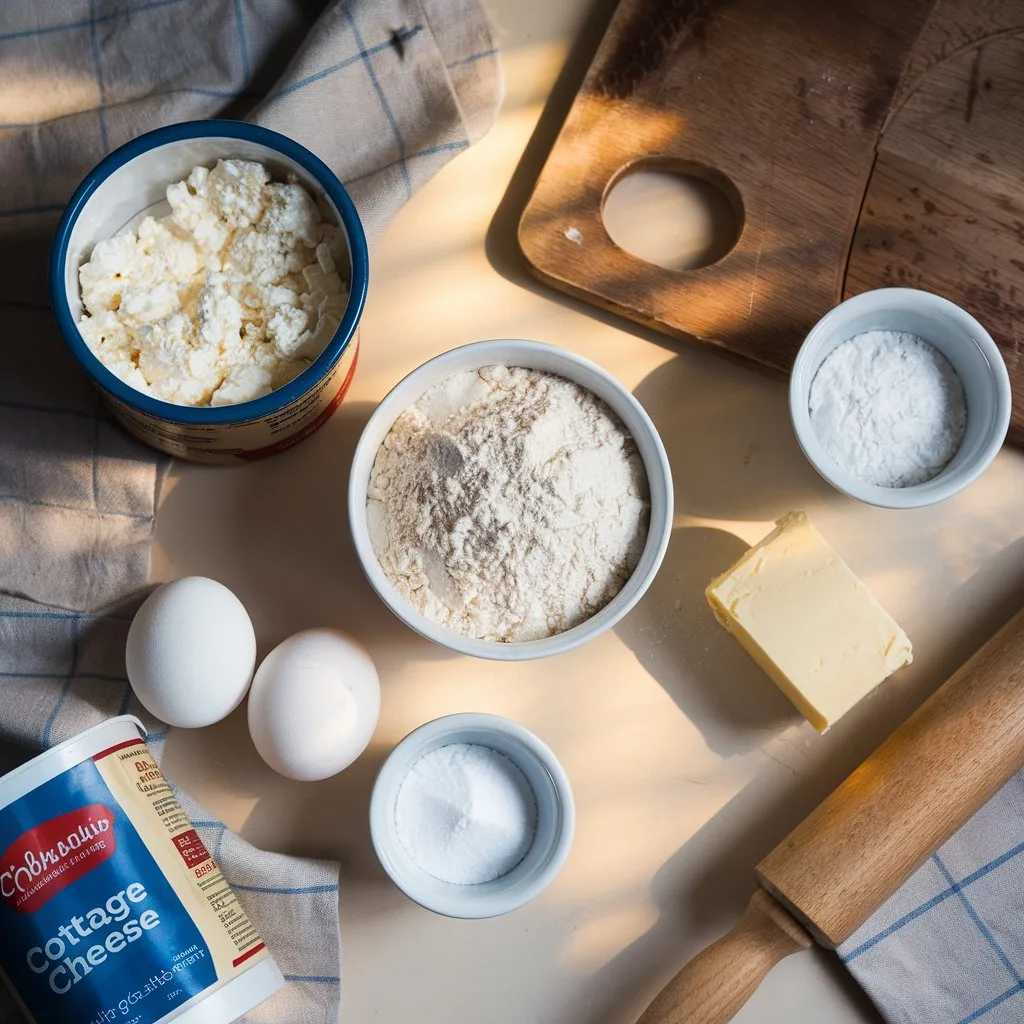
Essential Ingredients for Cottage Cheese Bread
Making the perfect cottage cheese bread is all about the right ingredients. Cottage cheese is the main ingredient, adding a unique texture and tanginess. The other ingredients work together to make the bread soft and savory.
Cottage Cheese: The Star Ingredient
The heart of cottage cheese bread is cottage cheese. It adds a special texture and a bit of tanginess. This makes the bread moist and tender, which is key.
Other Required Ingredients
Here are the other ingredients you need for a tasty savory cottage cheese bread:
- All-purpose flour: Gives the bread structure and a light texture.
- Baking powder: Helps the bread rise and become fluffy.
- Salt: Adds flavor and balances the sweetness.
- Eggs: Hold the ingredients together, making the bread richer.
- Butter: Adds a rich flavor and makes the crust soft.
By choosing and mixing these ingredients carefully, you can make a delicious cottage cheese bread. It will surely impress your loved ones.
“The key to making the perfect cottage cheese bread is finding the right balance of ingredients to create a soft, flavorful loaf.”
| Ingredient | Quantity | Function |
|---|---|---|
| Cottage Cheese | 1 cup | Provides moisture, texture, and tanginess |
| All-purpose Flour | 2 cups | Gives structure and a light, airy crumb |
| Baking Powder | 2 teaspoons | Acts as a leavening agent for rise and fluffiness |
| Salt | 1 teaspoon | Enhances the overall flavor profile |
| Eggs | 2 | Binds the ingredients and contributes to the structure |
| Butter | 4 tablespoons | Adds richness and helps create a soft, tender crust |
Step-by-Step Instructions for the Recipe
Making cottage cheese bread at home is simple. Follow these steps to make a soft, tasty loaf that will please your taste buds.
Preparing the Dough
First, get all the ingredients for your cottage cheese bread recipe. You’ll need cottage cheese, flour, yeast, salt, and any extra seasonings or mix-ins. In a big mixing bowl, mix the dry ingredients – flour, yeast, and salt – well.
Then, add the cottage cheese and any wet ingredients to the dry mix. Use a wooden spoon or a stand mixer with the dough hook to knead the dough. Do this until it’s smooth and elastic, about 5-10 minutes. If it’s too sticky, add a bit more flour until it’s right.
Shaping and Baking the Bread
After kneading, shape the dough into a loaf. Put it in a greased bread pan. Cover it with a clean towel and let it rise in a warm, draft-free spot for 30-60 minutes, or until it doubles in size.
Heat your oven to 375°F (190°C). When the dough is ready, bake the cottage cheese bread for 30-35 minutes. It should have a golden crust and a clean toothpick in the center. Let it cool in the pan for 10 minutes before moving it to a wire rack to cool fully.

With these easy steps, you can make a wonderful cottage cheese bread loaf. It’s perfect for any time, with its soft texture and mild cottage cheese flavor.
Tips for Making the Perfect Cottage Cheese Bread
Making the perfect homemade cottage cheese bread is a bit of an art. But with these expert tips, you’ll soon be baking loaves that rival those from the bakery. From picking the right cottage cheese to mastering kneading, we’ll cover the secrets to soft, flavorful bread every time.
Choosing the Right Cottage Cheese
The type of cottage cheese you choose greatly affects your bread’s texture and taste. For the best results, go for full-fat cottage cheese with a creamy, slightly chunky texture. Avoid low-fat or dry cottage cheese, as they can make your bread dense or dry.
Take the time to read labels and pick a high-quality cottage cheese. It will give your homemade cottage cheese bread a rich, moist crumb.
Don’t Skip the Kneading Process
Proper kneading is key for developing the gluten in your dough. Spend at least 10 minutes kneading by hand or with a stand mixer. This ensures the ingredients mix well and the dough becomes smooth and elastic.
Skipping this step can result in a heavy, dense loaf. So, be patient and knead until the dough can be stretched thin without tearing. This is known as the “windowpane test.”
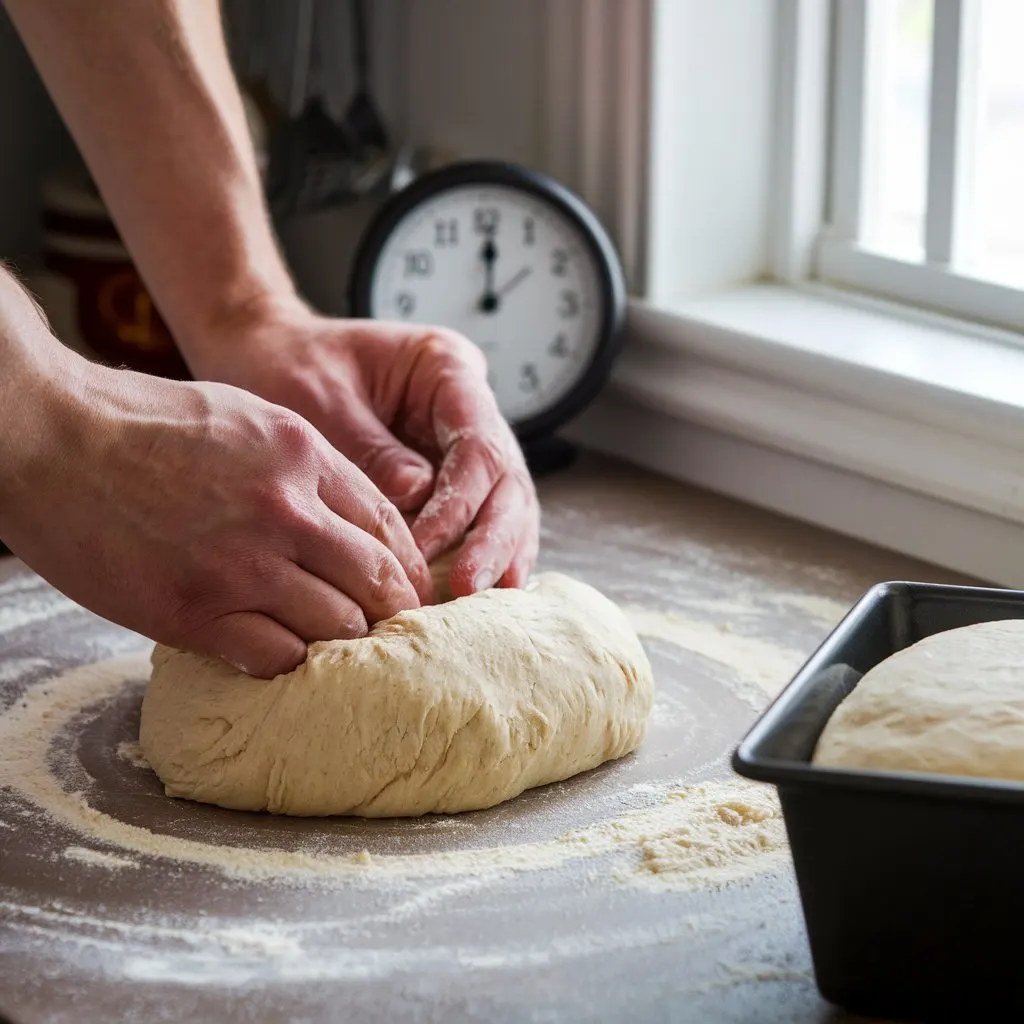
By following these simple tips, you’ll be well on your way to baking the cottage cheese bread of your dreams. Remember, the key is to use the right cottage cheese and take the time to properly knead the dough for the best possible texture and flavor.
How to Store Your Cottage Cheese Bread
Keeping your homemade cottage cheese bread fresh is key to enjoying its taste. A few simple storage tips can help. This way, your bread stays soft, moist, and ready to eat for days.
Best Practices for Storage
First, let your cottage cheese bread cool completely before storing. Then, wrap it in an airtight container or plastic bag. This keeps moisture in and prevents drying.
At room temperature, your bread can last 3-5 days. For longer freshness, refrigerate it. This can extend its life to up to 1 week.
Reheating Tips for Freshness
Lost some softness? No worries. Preheat your oven to 300°F (150°C). Place the bread on the rack for 5-8 minutes. This will make it feel fresh again without drying out.
Or, wrap it in foil and reheat for 10-15 minutes. This method works too.
With these tips, your cottage cheese bread stays delicious for days. A bit of care keeps it a tasty, easy meal addition.
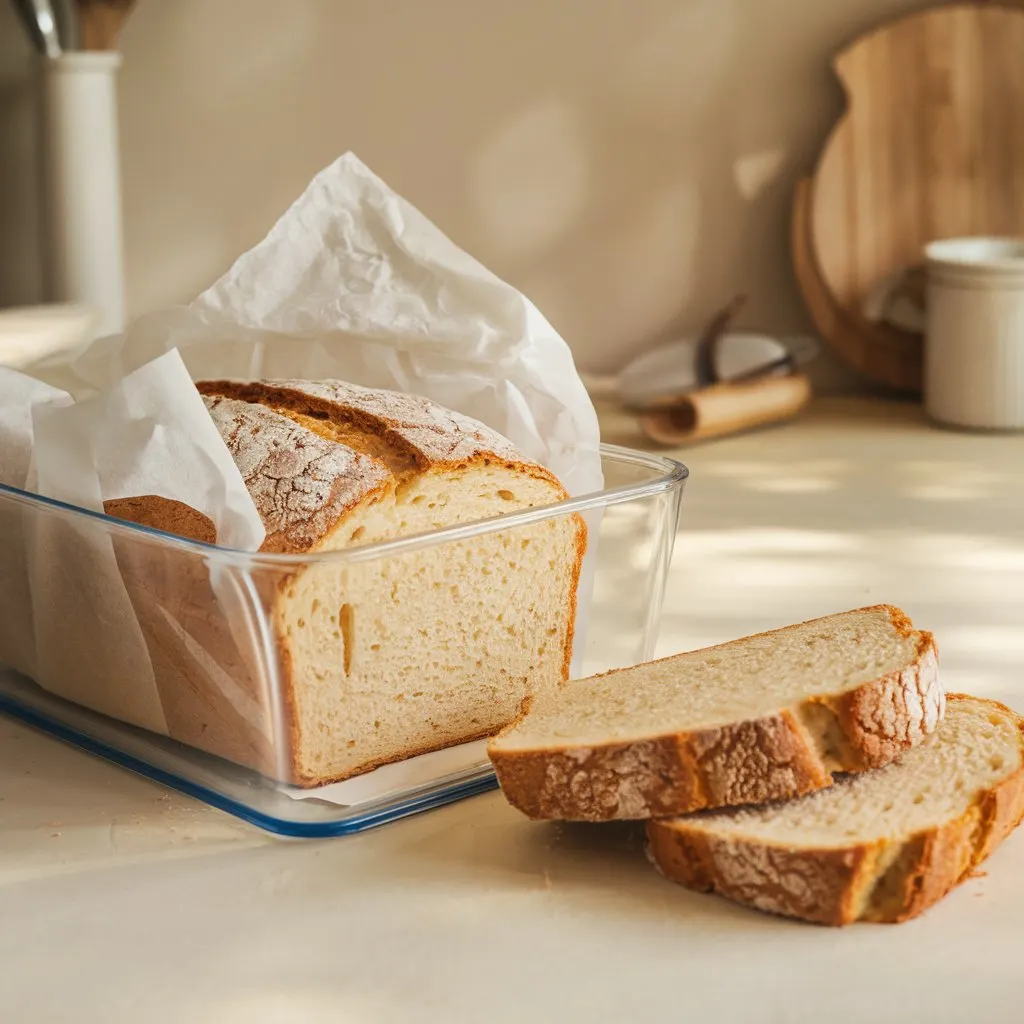
Variations to Try with Cottage Cheese Bread
Cottage cheese bread is a versatile staple that can be easily customized to suit your taste preferences. There are many creative variations you can try to add unique flavors and textures. Let’s explore some delicious options to elevate your cottage cheese bread experience.
Add Herbs and Spices for Flavor
Enhance your cottage cheese bread by adding aromatic herbs and spices. Try adding a tablespoon or two of chopped fresh herbs like rosemary, thyme, or basil to the dough. You can also experiment with dried spices such as garlic powder, onion powder, or paprika to add depth and complexity to the flavor profile.
Incorporating Vegetables or Cheese
For a heartier and more nutritious twist, consider adding vegetables to your cottage cheese bread. Finely shredded zucchini, diced bell peppers, or sautéed onions can add delightful bursts of flavor and texture. You can also sprinkle in shredded cheddar, parmesan, or crumbled feta cheese to create a savory, cheese-infused loaf.
The possibilities are endless when it comes to cottage cheese bread variations. Whether you prefer a herbed and spiced version or a vegetable-packed and cheesy delight, the key is to have fun and explore your culinary creativity. Embrace these savory cottage cheese bread ideas and create your own signature twist on this beloved bread.
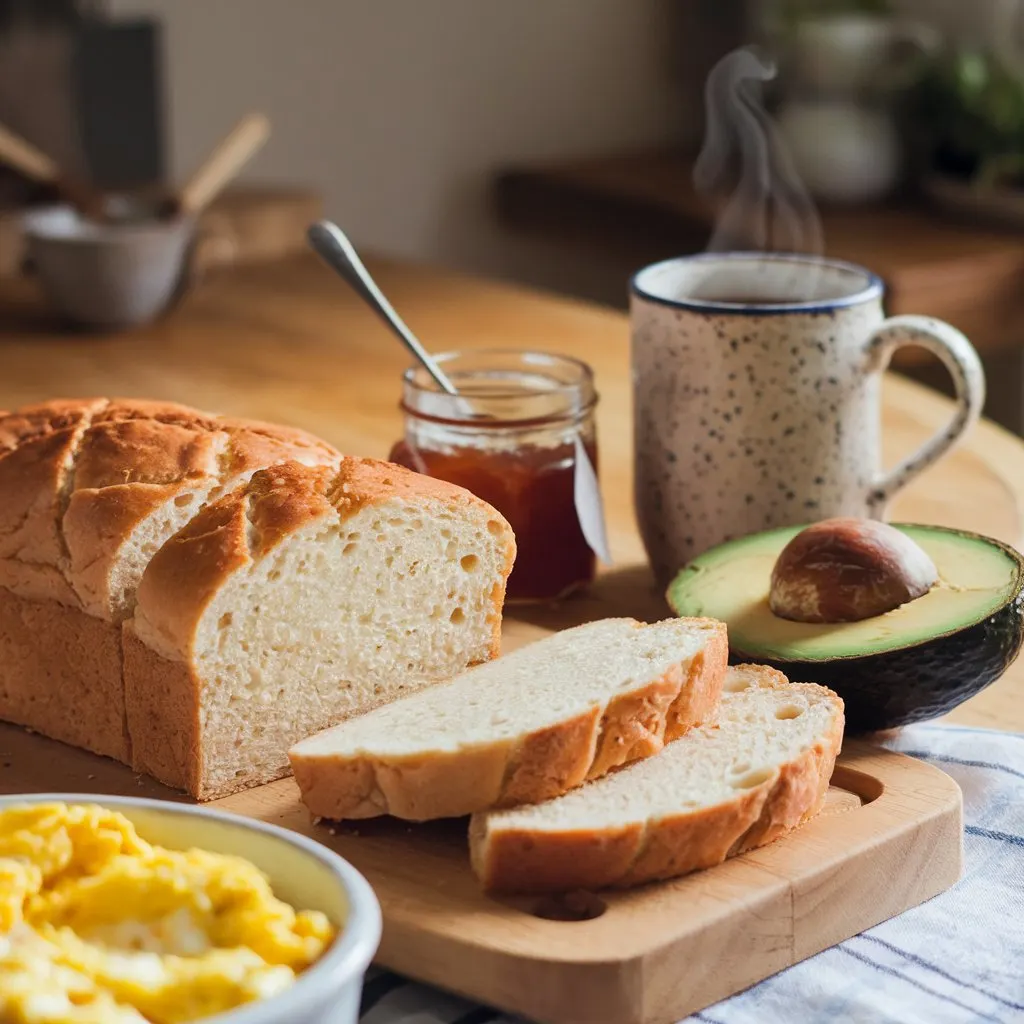
Serving Suggestions for Cottage Cheese Bread
Cottage cheese bread is a versatile baked good. It can be enjoyed in many ways. Whether you’re looking for the perfect pairing for your meals or creative uses for leftover bread, there are endless possibilities.
Ideal Pairings with Meals
Cottage cheese bread is great with many dishes. It’s perfect with hearty soups or stews, soaking up all the flavors. It also pairs well with grilled proteins like chicken or salmon, adding a delightful contrast.
For breakfast or brunch, cottage cheese bread is a perfect canvas for sweet toppings. Try it with jam, honey, or maple syrup. You can even toast slices and use them for a breakfast sandwich with eggs, cheese, and savory fillings.
Creative Ways to Use Leftover Bread
- Cubed and toasted, cottage cheese bread makes delightful croutons for salads or soups.
- Tear or slice the bread into pieces and use it as the base for a hearty bread pudding, baked with custard, fruits, or other sweet ingredients.
- Grate or pulse the bread in a food processor to create breadcrumbs, which can be used to coat chicken, fish, or as a topping for casseroles.
- Repurpose leftover slices into an indulgent French toast, layered with your favorite toppings and drizzled with maple syrup.
No matter how you choose to serve or repurpose your cottage cheese bread, you’re sure to enjoy its delicious flavor and versatility. Experiment with different pairings and ideas to make the most of this unique and satisfying baked good.
Common Issues and Troubleshooting
Making the perfect cottage cheese bread is a fun baking journey. But, it comes with its own set of challenges. You might face a few common problems that affect the bread’s texture and look. Don’t worry, with some troubleshooting, you can fix these issues and enjoy a soft, tasty loaf.
Addressing Dense or Dry Bread
One common issue is a dense or dry bread. This can happen if you overwork the dough, use too much flour, or don’t mix the cottage cheese well. Here are some solutions:
- Be gentle when kneading the dough, avoiding excessive handling that can develop too much gluten.
- Measure your ingredients carefully, using just the right amount of flour to achieve the desired consistency.
- Ensure the cottage cheese is well-incorporated into the dough, without leaving any dry pockets.
Solutions for Overproofing
Another problem is overproofing, which can make the loaf collapse or lose its shape. This happens when the dough rises too long, weakening the gluten and losing its shape. To avoid this:
- Pay close attention to the rising times outlined in the recipe, and don’t let the dough overproof.
- If you notice the dough has risen too much, gently punch it down to release the excess air and reshape it before baking.
- Consider using a proofing box or other controlled environment to ensure consistent rising times.
By tackling these common issues and following the recipe closely, you’ll be on your way to baking the perfect cottage cheese bread every time.
Nutrition and Health Benefits of Cottage Cheese Bread
Cottage cheese bread is not only tasty but also very nutritious. It’s made with cottage cheese, which is full of health benefits. This makes it a great choice for your meals.
Nutritional Value of Ingredients
Cottage cheese is the main ingredient in this bread. It’s rich in protein, calcium, and vitamins. When mixed with flour, eggs, and butter, it creates a bread that’s healthier than white bread.
Health Benefits of Cottage Cheese
Eating cottage cheese bread can improve your health in many ways. It has lots of protein, which is good for muscles. It also has calcium and vitamin D for strong bones and teeth.
The probiotics in cottage cheese help with digestion. Adding this bread to your diet can increase your nutrient intake. It’s a simple way to support your health goals.

